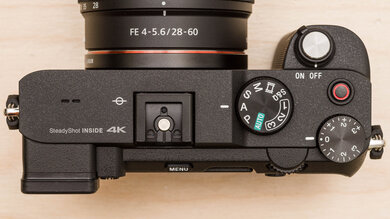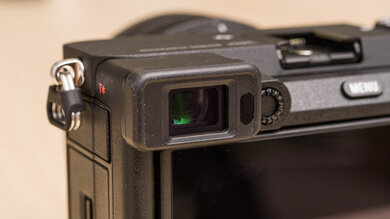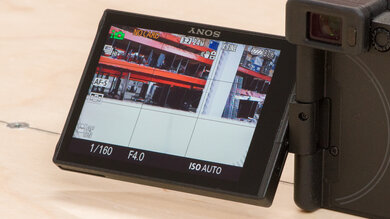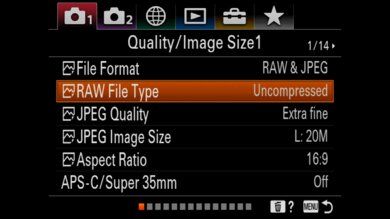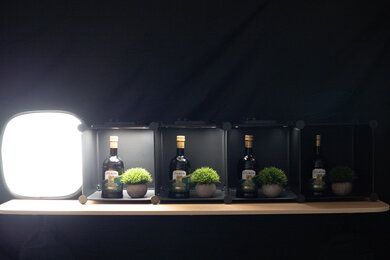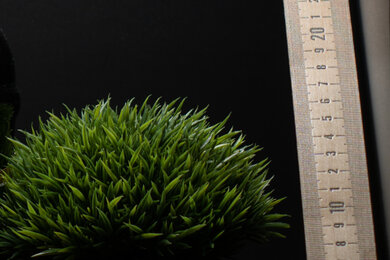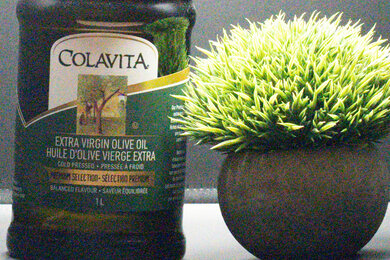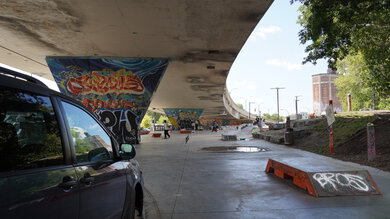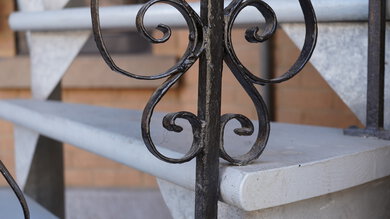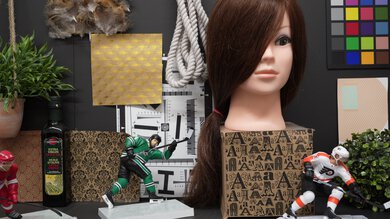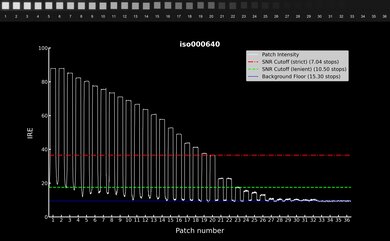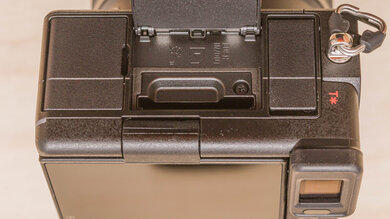The Sony α7C is the compact option in Sony's Alpha 7 lineup of full-frame mirrorless cameras. First released in 2020, it shares a lot of the same features as 2018's Sony α7 III, including the same 24-megapixel backside-illuminated sensor and processor, in-body image stabilization, and 10 fps burst shooting. However, it also offers some improvements, including an updated autofocus system and a fully articulating screen. Its compact size does come with a few trade-offs, though—namely, a much smaller and more uncomfortable viewfinder, fewer buttons and dials, and just a single SD card slot.
Our Verdict
The Sony a7C is great for travel photography. It's fairly lightweight and portable, especially for a full-frame camera. It captures incredibly high-quality images and performs well in low light, and it has a fantastic battery life that's sufficient for long days on the go. It also has an excellent autofocus system that reliably keeps moving subjects in focus. It isn't the most comfortable to use, with somewhat cramped ergonomics and a tiny viewfinder. Its menu system can also be a bit of a hassle to navigate.
- Relatively compact and lightweight.
- Remarkable image quality.
- Great RAW noise handling capability.
- Fantastic autofocus performance.
- Handgrip can feel a bit cramped.
- Menu system is somewhat hard to navigate.
- Terrible viewfinder.
The Sony a7C is impressive for landscape photography. Its image quality and RAW noise handling capability are great, and it has excellent dynamic range to bring out a wide array of detail in high-contrast landscape shots. It's also weather-sealed to protect against rain and humidity. Overall, the camera feels very well-built and is very portable for a full-frame camera, but its design leaves less room for a comfortable handgrip, especially for those with larger hands.
- Relatively compact and lightweight.
- Great RAW noise handling capability.
- Excellent dynamic range.
- Handgrip can feel a bit cramped.
- Menu system is somewhat hard to navigate.
The Sony a7C is great for sport and wildlife photography. It captures remarkably high-quality images with minimal noise in low light. It also has a relatively quick continuous shooting speed and a decent-sized image buffer, although it takes a while to empty if you manage to fill it, which can interrupt your shooting at a critical moment. On the other hand, it has an excellent autofocus system with a fantastic AF tracking feature that works well even with faster subjects. It also includes both human and animal eye detection, meaning you can tailor it to your particular subject.
- Relatively compact and lightweight.
- Remarkable image quality.
- Great RAW noise handling capability.
- Fantastic autofocus performance.
- Good continuous shooting speed.
- Handgrip can feel a bit cramped.
- Menu system is somewhat hard to navigate.
- Buffer empty time is a bit long.
- Terrible viewfinder.
The Sony a7C is good for vlogging, though this isn't its main intended use. While it's relatively compact and portable for a full-frame camera, it's still on the larger and heavier side for walk-and-talk vlogs. In-body image stabilization can help reduce camera shake, but it isn't as effective as some competitors. Still, the camera has a fully articulated screen so you can monitor yourself while recording, as well as an exceptional autofocus system to ensure your face stays in focus. Video quality is excellent, and there's no recording time limit. It has a fantastic battery life and isn't likely to overheat, even during extended recording sessions.
- Relatively compact and lightweight.
- Great overall video quality.
- Fantastic autofocus performance.
- Fully articulated screen.
- Handgrip can feel a bit cramped.
- Menu system is somewhat hard to navigate.
- Video stabilization is disappointing.
The Sony a7C is excellent for studio video. Its video quality is impressive, with excellent dynamic range, and it has good internal recording capability, though its recording format options are a bit limited, and its menu system can be hard to navigate. It supports several S-Log and HLG picture profiles. However, it's limited to 8-bit capture, giving you less flexibility to edit your footage. On the upside, its battery life is fantastic, it doesn't have a recording time limit, and it won't overheat, though this can vary with real-world conditions. It also comes with a full array of inputs and outputs, including a headphone jack and stereo microphone input, and a micro HDMI port to connect an external recorder. It only has one SD card slot, though, which is unfortunate if you prefer to keep a running backup while recording.
- Relatively compact and lightweight.
- Full array of inputs and outputs.
- Great overall video quality.
- Fantastic autofocus performance.
- Handgrip can feel a bit cramped.
- Menu system is somewhat hard to navigate.
The Sony Alpha 7C isn't meant for action video. While it's compact relative to other full-frame mirrorless cameras, it isn't designed to be mounted on a helmet or other action cam rig. It's weather-sealed but not fully waterproof. On the upside, it can record and playback FHD video at up to 120 fps, which is good for generating slow-motion footage, but its 4k frame rate options are more limited for high-speed recording.
- Relatively compact and lightweight.
- Can shoot in FHD at up to 120 fps.
- Great overall video quality.
- Fantastic autofocus performance.
- Handgrip can feel a bit cramped.
- Menu system is somewhat hard to navigate.
- Limited 4k frame rate options.
- Video stabilization is disappointing.
- Not waterproof.
The Sony a7C has excellent RAW photo performance. Its dynamic range is amazing, so it's well-suited to high-contrast scenes. It also does a great job of managing noise in low light, and its high-res sensor captures a great level of fine detail.
- Great RAW noise handling capability.
- Excellent dynamic range.
Performance Usages
Changelog
-
Updated Feb 12, 2025:
We wrote text for the new tests added in Test Bench 0.13 and updated the Verdict section accordingly.
- Updated Feb 03, 2025: We've converted this review to Test Bench 0.13. We've added new tests for Video Dynamic Range and Luminosity Patch Detection. You can learn more about these updates in the changelog.
-
Updated Nov 04, 2024:
We added a comparison to the Sony α7R IIIa in the Sensor box.
- Updated Sep 18, 2024: We added mention of the newly reviewed Panasonic LUMIX S9 as a point of comparison in the Portability section.
Check Price
Differences Between Sizes And Variants
The Sony Alpha 7C comes in two color variants: 'Black' and 'Silver.' We tested the black model, and you can see our unit's label. You can buy the camera in a bundle with the Sony FE 28–60mm f/4–5.6 lens, the Sony FE 24-105mm f/4& G OSS lens, or others, depending on the retailer. You can also buy it without a kit lens.
Let us know if you come across a different variant or if your Sony a7C doesn't correspond to our review, and we'll update it.
Popular Camera Comparisons
The Sony a7C is one of the most compact full-frame camera bodies on the market. It offers a lot of the same great features as the Sony a7 III, including a high-resolution full-frame sensor, in-body image stabilization, and 10 fps burst shooting, but in a more portable form factor. That comes with some tradeoffs, namely fewer buttons and dials, as well as a much smaller viewfinder. However, if you want portability without sacrificing image quality, this is a great option.
For more choices, check out our recommendations for the best full-frame mirrorless cameras, the best cameras for travel, or the best cameras overall.
The Sony α7C is essentially a more compact version of the Sony α7 III. Being newer, it offers a few improvements, including an upgraded autofocus system with a better AF tracking algorithm, plus a longer battery life and unlimited video recording time. That said, the α7 III has better ergonomics, with more custom buttons and dials, along with a significantly larger viewfinder and dual SD card slots. The α7 III also has a tilting screen, while the α7C has a fully articulated screen, one of which may suit you better than the other depending on your needs and personal preference.
The Sony α7C II replaces the Sony α7C. It includes a new higher-resolution sensor, a new processor, and an updated autofocus system. The Mark II also has more advanced video features, including internal 10-bit 4:2:2 capture and 4k 60p recording, albeit with a significant crop. That being said, both are excellent compact hybrid cameras, and if you already own an α7C, the differences aren't necessarily worth upgrading for.
The Sony α7C and the Sony α6700 are both amazing cameras in their respective classes, but they use different-sized sensors. Despite that, they're similar in size, design, and build quality, though the α6700 has a more comfortable hand grip. The α6700 also has a newer processor, an updated autofocus system, and better video capabilities. The α7C, on the other hand, has the benefit of a full-frame sensor, meaning it has a wider dynamic range and better noise handling in low light.
The Sony α7C is better than the Sony α6400, though they use different-sized sensors. The α7C's full-frame sensor outperforms the APS-C α6400 in dynamic range and low-light performance. It also features in-body image stabilization, a more effective autofocus system, and a longer battery life, but the α6400 is more portable.
Test Results

The Sony Alpha 7C is very portable for a full-frame camera. It's among the most compact full-frame mirrorless cameras on the market, surpassed only by the modular SIGMA fp L. Though it's a bit bulkier than APS-C alphas like the Sony a6600, it's closer in size and appearance to those cameras than full-frame Sony models like the Sony a7 III. If you want an even more compact full-frame camera, consider the Sony ZV-E1 or the Panasonic LUMIX S9.
Build quality is superb. The body is made out of magnesium alloy and feels sturdy. The buttons provide great physical feedback, and the screen mechanism feels solid. It's a slight step up from the Sony a7 III, with more robust weather-sealing and more secure input/output covers.
The Sony a7C has decent ergonomics given its compact size, though it isn't nearly as comfortable to shoot with as the Sony α7 III or the Sony α7 IV. There aren't as many custom buttons and dials, so it's a bit more of a hassle to adjust settings when shooting in manual mode. The buttons provide good physical feedback, and the textured grip feels nice and provides a secure hold. The camera is suitable for most hand sizes, but those with very large hands may find it a bit cramped, especially in the space between the grip and the lens.
The EVF is a lot smaller than the one found on the Sony α7 III, which is a compromise to help keep the size of the body down. It's even smaller and less comfortable than the EVFs on Sony's APS-C cameras like the Sony a6600. There's no rubber eyecup, and the plastic can get uncomfortable.
Unlike the Sony α7 III, this camera has a fully articulated screen. That makes it a little more convenient for video work or vlogs, but some may still prefer a tilting screen for waist-level photography. The screen has a decent resolution and gets quite bright, making it easier to see on brighter days. Unfortunately, touch functionality is mostly limited to selecting focus points, meaning you can't use it to navigate the menu.
The menu is okay to use, but it isn't very intuitive, with many submenus and pages that aren't very clearly organized. It makes it harder to find more complex settings, and it isn't helped by the lack of touch navigation. That said, the camera includes a ton of customization options, including the option to create a custom menu for the specific settings you use most. The quick menu ('Fn' menu) also gives you access to commonly used settings while shooting.
If you need a higher-resolution camera, the Sony α7R IIIa offers almost twice the resolution as the α7C, though it isn't as compact.
The Sony a7C has a fantastic battery life. With a 680-shot CIPA rating, it's one of the highest-rated mirrorless cameras we've tested for photos, though that still falls far short of many high-end DSLRs. The number of shots you get in real-world usage can also vary greatly depending on your settings and how you use your camera. Still, you can expect to get plenty of photos out of this camera before having to recharge.
When it comes to video, the camera also performs incredibly well, lasting for over two hours of continuous 4k video recording in our testing with no overheating interruptions.
Continuous shooting is decent. The camera can shoot at a reasonably quick max burst rate and has a slightly larger buffer capacity than the Sony a7 III. However, if you do manage to fill it up while shooting, it takes quite a while for it to empty, which isn't great when the timing is critical.
The AF tracking on the Sony a7C is fantastic. It uses a sophisticated hybrid phase detection autofocus system, with Sony's 'Real Time Eye AF', which seamlessly switches between eyes, faces, and general subject tracking, and it can predict and keep track of moving subjects with high accuracy. Even with faster subjects or in trickier environments, it's very likely to nail focus and leave you with plenty of keepers.
When using center point AF, along with a lens that has a good focusing motor, the camera very smoothly stays with subjects that are in the focus point. All in all, it's an incredible reliable autofocus system that's well-suited to almost any shooting situation.
The Sony a7C includes in-body image stabilization, which Sony calls 'SteadyShot'. It works in tandem with the Optical SteadyShot in Sony lenses. It works very well, allowing you to capture clear photos at very slow shutter speeds. That said, stabilization performance can vary depending on your lens, focal length, and even the steadiness of your hands.
The Sony a7C has excellent dynamic range, allowing you to capture a wide array of highlight and shadow detail. It does drop off when there's less available light, but it's still very good overall.
This camera is excellent at resolving fine detail thanks to its high-res full-frame sensor. Even when punching in or cropping, you can expect plenty of detail and resolution.
Noise handling is great. This camera is well-suited to taking photos in low light at higher ISO settings. Noise is inevitable with less light and shorter exposures, but you can push the camera far without getting overly noisy images.
The camera supports S-Log2 and S-Log3, which capture a "flatter" image to record a wider range of detail. That said, it's limited to 8-bit video output, meaning you'll have a harder time getting the most out of Log profiles when color-grading your footage.
Internal recording capability is great. There's no recording time limit, which is nice. Bit rates are decent, meaning the camera can capture a fair amount of information for high-quality video files, but it falls far short of what the newer Sony α7 IV is capable of. Unfortunately, it's also limited to 8-bit 4:2:0 recording, which gives you less leeway to color grade and edit your footage. If you need internal 10-bit 4:2:2 recording, check out the Sony α7C II.
Autofocus is incredible when recording 4k video. Unlike the Sony a7 III, eye AF is available in video mode as well as photo mode, meaning you can get more precise focus on a subject's eyes. The tracking feature works very well overall, so you can generally rely on it to keep your subjects in focus, even when they're moving faster or more erratically.
Rolling shutter effect isn't too bad. There's some noticeable skewing with faster camera pans, but it could be worse. Slower movements won't be too distracting.
1080p internal recording is great. As with 4k, there's no time limit on recording. Unfortunately, it's still limited to 8-bit 4:2:0, so it can't capture as much color information, giving you less latitude to edit and manipulate your videos.
In 1080p, autofocus is just as fantastic as in 4k. The face and eye tracking feature work incredibly well, so you can rely on the camera to keep moving subjects in focus.
Distortion from the rolling shutter is much less noticeable in 1080p. There's still a bit of skewing with very fast camera movements, but overall, the rolling shutter won't be too distracting.
The Sony Alpha 7C records a very wide dynamic range above the background floor, but noise starts to creep into footage pretty quickly. Despite that, you'll still have a usable dynamic range of about 10 or 11 stops, which is great and gives you more flexibility with high-contrast scenes.
Tested Settings:
- Resolution: 4k
- Frame Rate: 30 fps
- Log Format: S-Log3
The camera has a very wide ISO range, and while most of its dynamic range is allocated to the shadows, it does a good job of preserving highlight detail as you raise the ISO.
Tested Settings:
- Resolution: 4k
- Frame Rate: 30 fps
- Log Format: S-Log3
Unfortunately, there's only a single SD card slot, unlike the dual slots you get with the Sony a7 III. On the upside, the SD card slot is well-placed on the side of the camera, so you can easily switch out memory cards when shooting on a tripod.
There are plenty of inputs and outputs to connect peripherals like headphones, a microphone, or an external monitor. There's also a USB-C port for charging. The flaps that cover the inputs feel a lot more secure than those on the Sony a7 III, with hinged doors and gaskets.



